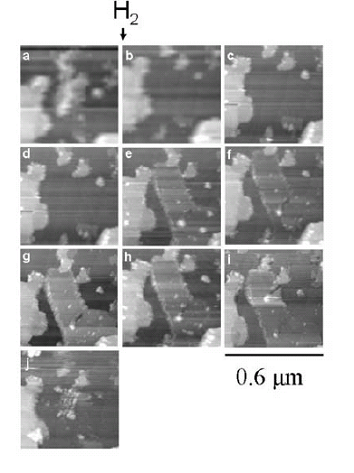Subsurface STM imaging of electrically floating islands
Yishay Manassen
We are studying hydrogen absorption and corrosion on a metal surface. The system studied was Gd on W(110). This system was exposed to several Langmuirs of hydrogen. In the image below we see a series of consecutive images taken above the same place. The time between two images is about ½ hour. The phenomenon which is clearly distinguishable is the periodic appearance and disappearance of several islands. Since the islands appear and disappear exactly in the same shape, it clear that the island is not vanishing but somehow becomes transparent to the STM imaging process. As seen below, in some cases, the STM tip is imaging the surface under the island.
The process that is causing this phenomenon is the fact that hydrogen creates an insulating barrier between the Gd island and the W substrate. Thus the island is disconnected electrically from the substrate. As a result, the potential of the island is floating and when it is equal to the potential of the tip, the island is becoming part of the tip and the surface under the island is imaged.
The periodicity of the process is due to a competition between the stress induced by the hydride nuclei seen in the island as white protrusions and the stress in the insulating layer between the tungsten substrate and the gadolinium island.

- Further reading:
- Surf. Sci. 600 2795 (2006).